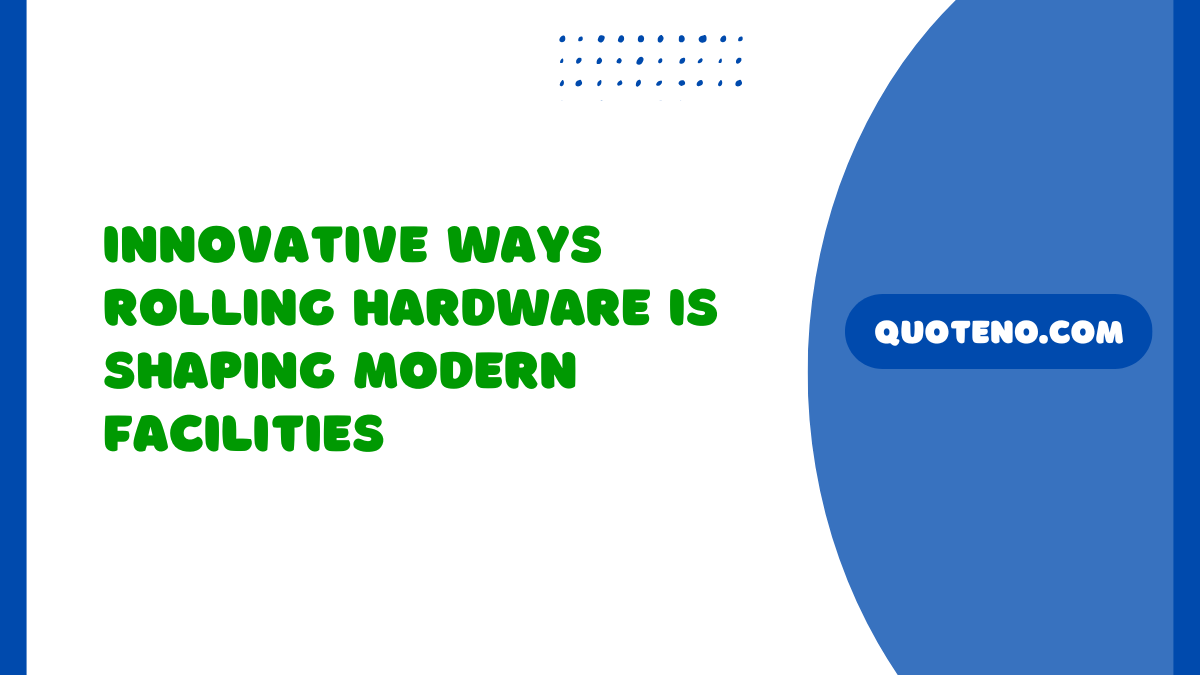Key Takeaways
- Rolling hardware innovations are transforming facility design, efficiency, and user experience.
- Trends include smart technology, enhanced security options, sustainable materials, and hygiene-focused finishes.
- Customization, modularity, and AI-driven solutions are driving the future of facility hardware management.
Modern facilities increasingly depend on innovative hardware solutions to balance efficiency, aesthetics, and robust performance. Among these solutions, stainless steel roller bearings stand at the forefront, delivering both reliability and smooth mobility essential to the evolving needs of contemporary spaces. These rolling mechanisms form the backbone of doors, partitions, and furniture, blending seamlessly into complex facility infrastructure.
As the industry pivots towards smarter, more adaptive environments, rolling hardware technology has adapted, offering enhanced precision and groundbreaking applications. Whether they enable quiet, smooth gliding of heavy doors or bring agile mobility to vital medical equipment, these advancements are crucial to the operational flow of modern buildings.
Table of Contents
Advancements in Roll Forming Technologies
In recent years, roll forming technology—a process for shaping metals into complex profiles—has gone through a remarkable transformation. Modern machines equipped with digital controllers and automated systems now create intricate shapes on demand with minimal material loss. This evolution means construction crews and facility managers can source profile solutions customized by project, whether for security doors or structural ceilings, while benefiting from improved consistency and reduced manufacturing costs.
The automation embedded in today’s roll forming equipment reduces labor intensity, accelerates project timelines, and promotes quality assurance. These benefits are crucial for facilities that require frequent updates and renovations, especially in sectors such as healthcare, education, and logistics, where time and accuracy are vital.
Integration of Smart Technology in Furniture Hardware
Furniture hardware today extends well beyond mechanical functionality, entering an era defined by convenience and connected experiences. Push-to-open mechanisms eliminate the need for traditional handles, creating minimalist yet intuitive user interfaces. In workplace and hospitality environments, these advances improve accessibility while catering to modern design trends. In addition to these mechanical upgrades, many manufacturers are embedding electronic components such as LED lighting and wireless charging docks directly into furniture, enhancing both form and function.
Enhancing Facility Security with Advanced Rolling Hardware
Robust security remains a fundamental requirement for all facilities, making the newest rolling hardware technologies indispensable. Today’s digital door hardware integrates biometric authentication, remote management, and real-time alerts that strengthen facility security. Integration with comprehensive building management systems enables administrators to monitor and control hardware performance and access, thereby protecting sensitive areas while simplifying authorized entry.
Promoting Sustainability Through Eco-Friendly Materials
Rising environmental standards have shifted rolling hardware manufacturing towards sustainability. The industry now emphasizes the use of recycled or recyclable metals and environmentally benign coatings, reducing the ecological footprint while maintaining the high standards of durability facilities demand. These sustainable practices not only help organizations meet green building certifications but also resonate with occupants who value eco-conscious environments.
Customization and Modular Solutions in Rolling Hardware
The increasing complexity and specialization of modern spaces have led to a surge in demand for customizable and modular hardware systems. Facilities can now specify rolling hardware solutions tailored to their operational demands, from interchangeable track systems to scalable mounting options. This modularity allows organizations to accommodate evolving requirements without the need for costly overhauls or wholesale hardware replacement, making it an optimal solution for growing businesses or multi-use spaces.
Improving Hygiene with Antimicrobial Finishes
Maintaining hygienic environments is paramount in healthcare, food service, and public spaces. Rolling hardware lines increasingly feature antimicrobial coatings that proactively curb the growth of bacteria and other pathogens on high-contact surfaces. Such innovations help reduce the risk of disease transmission and support ongoing cleaning protocols, fostering safer and more hygienic environments for occupants and visitors alike.
Future Outlook: The Role of AI and IoT in Rolling Hardware
Looking ahead, the fusion of Artificial Intelligence (AI) and the Internet of Things (IoT) with rolling hardware promises to revolutionize building maintenance and security. Smart sensors can monitor the condition and usage patterns of hardware components, enabling predictive maintenance and real-time performance adjustments. As AI-driven systems take hold, facility teams gain proactive insight, optimizing uptime, minimizing disruptions, and ensuring hardware continues to deliver optimal value throughout its lifecycle.
The ongoing evolution of rolling hardware technology demonstrates its critical role in facility management and construction. As these systems become increasingly connected, sustainable, and adaptive, they continue to power the infrastructure and operational excellence demanded by today’s high-performance buildings.
Frequently Askes Questions
What is rolling hardware?
Rolling hardware refers to components like caster wheels, conveyor rollers, and industrial rolling platforms or containers that enable smooth and efficient mobility of equipment and goods across factory or warehouse environments.
What types of rolling hardware are commonly used?
Common types include synthetic or nylon caster wheels for light duty, steel or stainless-steel rollers for heavy loads, and rolling storage containers for secure, movable inventory transport.
What are the key benefits of using rolling hardware?
Rolling hardware boosts workflow efficiency, reduces manual labor, increases safety, and supports ergonomic material handling by enabling easy movement of heavy or frequent loads across factory or distribution lines.
How do I choose the right rolling hardware for industrial use?
Consider factors such as load capacity, floor surface, material (rubber, polymer, steel), and mobility needs (swivel or rigid castors). Matching these ensures durability, smooth operation, and less wear over time.
- Divorce Annulments Demystified: Facts, Misconceptions, and What to Know - December 8, 2025
- Setting Healthy Boundaries for Better Mental Wellness - November 20, 2025
- Creative Ways to Make Camping Trips Fun for Everyone - November 7, 2025

